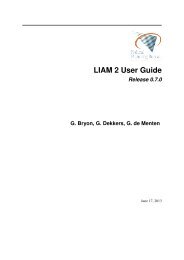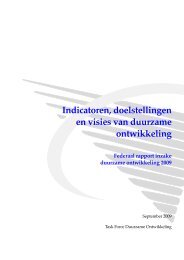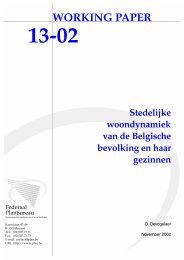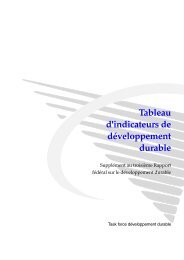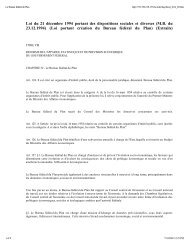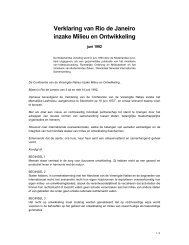long-term care use and supply in europe: projections for germany ...
long-term care use and supply in europe: projections for germany ...
long-term care use and supply in europe: projections for germany ...
You also want an ePaper? Increase the reach of your titles
YUMPU automatically turns print PDFs into web optimized ePapers that Google loves.
3. De<strong>term</strong><strong>in</strong>ants of <strong>use</strong> of <strong>for</strong>mal <strong>and</strong> <strong>in</strong><strong>for</strong>mal personal <strong>care</strong> by older<br />
persons liv<strong>in</strong>g at home: Evidence from Germany, the Netherl<strong>and</strong>s<br />
<strong>and</strong> Spa<strong>in</strong><br />
Joanna Geerts, Federal Plann<strong>in</strong>g Bureau<br />
Introduction<br />
Population age<strong>in</strong>g is expected to substantially <strong>in</strong>crease the number of <strong>care</strong> dependent older persons <strong>and</strong>,<br />
consequently, the number of <strong>long</strong>-<strong>term</strong> <strong>care</strong> (LTC) <strong>use</strong>rs <strong>in</strong> future years. The impact of population<br />
age<strong>in</strong>g on <strong>for</strong>mal <strong>and</strong> <strong>in</strong><strong>for</strong>mal <strong>care</strong> <strong>use</strong> is, however, likely to differ considerably across European<br />
countries. Populations are, <strong>in</strong> fact, age<strong>in</strong>g to a different extent <strong>and</strong> at a different pace. Furthermore, LTC<br />
is currently be<strong>in</strong>g organised <strong>and</strong> f<strong>in</strong>anced <strong>in</strong> very different ways <strong>and</strong> the extent to which older persons<br />
rely on <strong>for</strong>mal or <strong>in</strong><strong>for</strong>mal <strong>care</strong>rs varies widely between countries.<br />
In mak<strong>in</strong>g <strong>projections</strong> of future <strong>use</strong> of <strong>for</strong>mal <strong>and</strong> <strong>in</strong><strong>for</strong>mal <strong>care</strong> by older persons liv<strong>in</strong>g at home, it is<br />
important to discern the ma<strong>in</strong> factors affect<strong>in</strong>g <strong>care</strong> utilisation. Whether older persons are rely<strong>in</strong>g on<br />
<strong>for</strong>mal or <strong>in</strong><strong>for</strong>mal <strong>care</strong>givers depends on <strong>in</strong>dividual level characteristics such as the level of <strong>care</strong><br />
dependency <strong>and</strong> the potential availability of <strong>in</strong><strong>for</strong>mal <strong>care</strong>, but is also de<strong>term</strong><strong>in</strong>ed by societal <strong>and</strong> <strong>care</strong><br />
system level factors such as available <strong>supply</strong> <strong>and</strong> organisational characteristics of <strong>for</strong>mal <strong>care</strong> services.<br />
Given the huge variation across Europe <strong>in</strong> availability <strong>and</strong> allocation of <strong>care</strong> services, one can<br />
reasonably expect there to be differences between countries not only <strong>in</strong> levels of <strong>for</strong>mal <strong>and</strong> <strong>in</strong><strong>for</strong>mal<br />
<strong>care</strong> <strong>use</strong>, but also <strong>in</strong> how <strong>care</strong> <strong>use</strong> is related to older persons’ characteristics. For <strong>in</strong>stance, <strong>in</strong> countries<br />
with strong needs-based entitlements to LTC services one would expect <strong>use</strong> of <strong>for</strong>mal <strong>care</strong> not only to be<br />
higher, but also to be more strongly associated with disability <strong>and</strong> less related to potential availability of<br />
<strong>in</strong><strong>for</strong>mal <strong>care</strong> than <strong>in</strong> countries where access is means-tested <strong>and</strong> services are targeted at persons without<br />
<strong>in</strong><strong>for</strong>mal support.<br />
This chapter analyses similarities <strong>and</strong> differences <strong>in</strong> de<strong>term</strong><strong>in</strong>ants of <strong>in</strong><strong>for</strong>mal <strong>and</strong> <strong>for</strong>mal personal <strong>care</strong><br />
<strong>use</strong> <strong>in</strong> Germany, the Netherl<strong>and</strong>s <strong>and</strong> Spa<strong>in</strong>, each representative of a cluster of countries with a different<br />
LTC system, as identified by Kraus et al. (2010) <strong>in</strong> work package (WP) 1 of the ANCIEN project. 7 The<br />
ma<strong>in</strong> purpose of this study is to estimate probabilities of <strong>in</strong><strong>for</strong>mal <strong>and</strong> <strong>for</strong>mal <strong>care</strong> <strong>use</strong> by relevant<br />
characteristics of older persons, which will be <strong>use</strong>d <strong>in</strong> <strong>projections</strong> of future LTC <strong>care</strong> <strong>use</strong> by older people<br />
(see Chapter 4). Us<strong>in</strong>g multivariate models, the probabilities of different categories of <strong>care</strong> <strong>use</strong> (no <strong>care</strong>,<br />
<strong>in</strong><strong>for</strong>mal <strong>care</strong> only, <strong>for</strong>mal <strong>care</strong> only, <strong>for</strong>mal <strong>and</strong> <strong>in</strong><strong>for</strong>mal <strong>care</strong>) are l<strong>in</strong>ked to factors such as age, gender,<br />
health problems <strong>and</strong> ho<strong>use</strong>hold composition of older persons. The analysis is based on data of the<br />
Survey of Health, Age<strong>in</strong>g <strong>and</strong> Retirement <strong>in</strong> Europe (SHARE) <strong>and</strong> builds on WP 3 analyses of factors<br />
de<strong>term</strong><strong>in</strong><strong>in</strong>g <strong>care</strong> <strong>use</strong> <strong>in</strong> European countries (Jiménez-Martín, Vegas Sánchez, & Vilaplana Prieto, 2011;<br />
Marc<strong>in</strong>kowska & Sowa, 2011), but adds to the previous f<strong>in</strong>d<strong>in</strong>gs <strong>in</strong> its focus on older persons (aged 65<br />
<strong>and</strong> over) <strong>and</strong> on help with personal <strong>care</strong> tasks only. Help with ho<strong>use</strong>hold tasks has not been <strong>in</strong>cluded <strong>in</strong><br />
the present analysis as comparability of ho<strong>use</strong>hold help data turned out to be limited (see section 3.2.2<br />
below) <strong>and</strong> the LTC <strong>projections</strong> <strong>in</strong>clude help with personal <strong>care</strong> only.<br />
The next section briefly reviews studies of the de<strong>term</strong><strong>in</strong>ants of home <strong>care</strong> utilisation by older persons.<br />
The aim of the analysis <strong>and</strong> the data, variables <strong>and</strong> method <strong>use</strong>d, are discussed <strong>in</strong> section 3.2. Empirical<br />
results <strong>for</strong> Germany, the Netherl<strong>and</strong>s <strong>and</strong> Spa<strong>in</strong> are described <strong>in</strong> section 3.3, which discusses<br />
country-specific f<strong>in</strong>d<strong>in</strong>gs as well as similarities <strong>and</strong> differences between the three countries. The chapter<br />
ends with a summary of the ma<strong>in</strong> f<strong>in</strong>d<strong>in</strong>gs.<br />
3.1 De<strong>term</strong><strong>in</strong>ants of home <strong>care</strong> utilisation<br />
De<strong>term</strong><strong>in</strong>ants of <strong>for</strong>mal home <strong>care</strong> utilisation have been exam<strong>in</strong>ed <strong>in</strong> numerous studies, predom<strong>in</strong>antly<br />
<strong>in</strong> the United States, but also <strong>in</strong> Europe (see Kadush<strong>in</strong>, 2004a <strong>for</strong> a review). The behavioural model of<br />
health service <strong>use</strong> proposed by Andersen <strong>and</strong> colleagues (Andersen, 1995, 2008; Andersen & Newman,<br />
7 An analysis of Pol<strong>and</strong>, the representative country <strong>for</strong> the fourth cluster, was not possible due to data limitations.<br />
| 15



